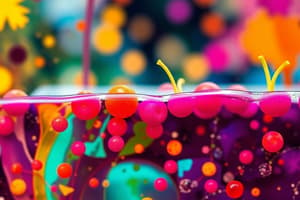Podcast
Questions and Answers
Which of the following is a nutrient required in minute amounts for microbial growth?
Which of the following is a nutrient required in minute amounts for microbial growth?
- Turbidity
- Viable counting
- Macronutrients
- Trace metals (correct)
What is used as a measure of microbial cell numbers based on its cloudiness?
What is used as a measure of microbial cell numbers based on its cloudiness?
- Cell nutrition
- Growth media
- Turbidity (correct)
- Viable counting
What is the main topic of Microbiology Lecture 4?
What is the main topic of Microbiology Lecture 4?
- Chemical makeup of a microbial cell
- Microbial periodic table of the elements
- Cell nutrition
- Dynamics of microbial growth (correct)
Which method provides information on viable cell counts?
Which method provides information on viable cell counts?
What is the main limitation of microscopic cell counting?
What is the main limitation of microscopic cell counting?
What does serial dilutions for viable counts involve?
What does serial dilutions for viable counts involve?
In which fields are applications of viable counts commonly found?
In which fields are applications of viable counts commonly found?
What are turbidity measurements commonly used for?
What are turbidity measurements commonly used for?
What does generation time refer to in microbial growth?
What does generation time refer to in microbial growth?
Which phase is not part of the typical growth curve in a culture of fixed volume?
Which phase is not part of the typical growth curve in a culture of fixed volume?
What is a chemostat culture?
What is a chemostat culture?
What is involved in biofilm growth?
What is involved in biofilm growth?
What terms are used in describing microbial growth?
What terms are used in describing microbial growth?
What does spectrophotometric measurement of microbial growth involve?
What does spectrophotometric measurement of microbial growth involve?
What is a key characteristic of biofilm growth?
What is a key characteristic of biofilm growth?
What is the approximate dry weight of E. coli?
What is the approximate dry weight of E. coli?
Which elements make up 96% of the dry weight of E. coli?
Which elements make up 96% of the dry weight of E. coli?
What is the purpose of solid media prepared with agar in microbial culture?
What is the purpose of solid media prepared with agar in microbial culture?
What are the essential macronutrients for microbes?
What are the essential macronutrients for microbes?
Which technique is used to transfer cultures without contamination and to count live cells using vital dyes and counting chambers?
Which technique is used to transfer cultures without contamination and to count live cells using vital dyes and counting chambers?
What is the function of trace elements and growth factors in microbial growth?
What is the function of trace elements and growth factors in microbial growth?
Which type of media requires prior knowledge of microbial nutrition requirements and is used for genetic studies involving prototrophic mutants?
Which type of media requires prior knowledge of microbial nutrition requirements and is used for genetic studies involving prototrophic mutants?
What is the approximate water content in E. coli cell weight?
What is the approximate water content in E. coli cell weight?
What is the purpose of differential media in microbial culture?
What is the purpose of differential media in microbial culture?
Which technique is used to observe microbial cell numbers but can be prone to technical errors and lack reproducibility?
Which technique is used to observe microbial cell numbers but can be prone to technical errors and lack reproducibility?
What is the purpose of enriched media in microbial culture?
What is the purpose of enriched media in microbial culture?
What is the main component of solid media used for microbial culture?
What is the main component of solid media used for microbial culture?
Flashcards are hidden until you start studying
Study Notes
Microbial Nutrition and Culturing Techniques
- E. coli cell weight is approximately 1 pg, with 75% of its weight being water and a dry weight of 184 fg.
- Carbon, oxygen, nitrogen, phosphorus, and sulfur make up 96% of the dry weight of E. coli.
- Macronutrients for microbes include carbon, nitrogen, oxygen, phosphorus, and sulfur, obtained from various sources such as organic polymers, carbon dioxide, proteins, and inorganic phosphate.
- Trace elements and growth factors are essential for microbial growth, serving various functions such as enzyme activation and precursor synthesis.
- Different classes of culture media for microbial growth include nutrient solutions, defined media, complex media, selective media, differential media, and enriched media.
- Complex media can grow a range of bacteria, while defined media require prior knowledge of microbial nutrition requirements and are used for genetic studies involving prototrophic mutants.
- Solid media, prepared with agar, are used to culture microbes and enable the observation of colony morphology, aiding in microorganism identification and purity determination.
- Aseptic techniques, like streak plate technique and counting microbial cell numbers with microscopes, are used to transfer cultures without contamination and to count live cells using vital dyes and counting chambers.
- Staining cells with dyes and counting under a bright-field microscope or phase-contrast microscope can be used to determine microbial cell numbers, but this method can be prone to technical errors and lack reproducibility.
Studying That Suits You
Use AI to generate personalized quizzes and flashcards to suit your learning preferences.




